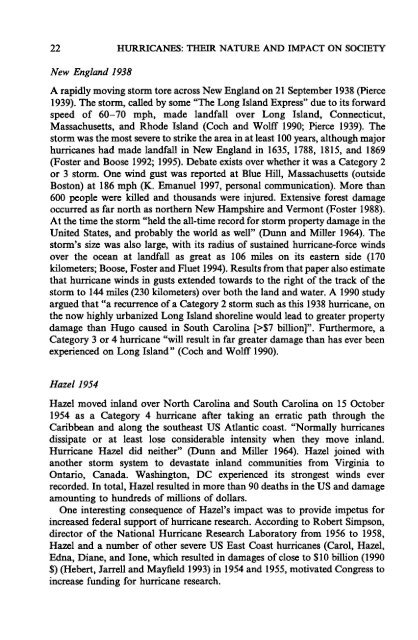Hurricanes: Their Nature and Impacts on Society - Climate Science ...
Hurricanes: Their Nature and Impacts on Society - Climate Science ...
Hurricanes: Their Nature and Impacts on Society - Climate Science ...
You also want an ePaper? Increase the reach of your titles
YUMPU automatically turns print PDFs into web optimized ePapers that Google loves.
22 HURRICANES: THEIR NATURE AND IMPACT ON SOCIETY<br />
New Engl<str<strong>on</strong>g>and</str<strong>on</strong>g> 1938<br />
A rapidly moving storm tore across New Engl<str<strong>on</strong>g>and</str<strong>on</strong>g> <strong>on</strong> 21 September 1938 (Pierce<br />
1939). The storm, called by some "The L<strong>on</strong>g Isl<str<strong>on</strong>g>and</str<strong>on</strong>g> Express" due to its forward<br />
speed of 60-70 mph, made l<str<strong>on</strong>g>and</str<strong>on</strong>g>fall over L<strong>on</strong>g Isl<str<strong>on</strong>g>and</str<strong>on</strong>g>, C<strong>on</strong>necticut,<br />
Massachusetts, <str<strong>on</strong>g>and</str<strong>on</strong>g> Rhode Isl<str<strong>on</strong>g>and</str<strong>on</strong>g> (Coch <str<strong>on</strong>g>and</str<strong>on</strong>g> Wolff 1990; Pierce 1939). The<br />
storm was the most severe to strike the area in at least 100 years, although major<br />
hurricanes had made l<str<strong>on</strong>g>and</str<strong>on</strong>g>fall in New Engl<str<strong>on</strong>g>and</str<strong>on</strong>g> in 1635, 1788, 1815, <str<strong>on</strong>g>and</str<strong>on</strong>g> 1869<br />
(Foster <str<strong>on</strong>g>and</str<strong>on</strong>g> Boose 1992; 1995). Debate exists over whether it was a Category 2<br />
or 3 storm. One wind gust was reported at Blue Hill, Massachusetts (outside<br />
Bost<strong>on</strong>) at 186 mph (K. Emanuel 1997, pers<strong>on</strong>al communicati<strong>on</strong>). More than<br />
600 people were killed <str<strong>on</strong>g>and</str<strong>on</strong>g> thous<str<strong>on</strong>g>and</str<strong>on</strong>g>s were injured. Extensive forest damage<br />
occurred as far north as northern New Hampshire <str<strong>on</strong>g>and</str<strong>on</strong>g> Verm<strong>on</strong>t (Foster 1988).<br />
At the time the storm "held the all-time record for storm property damage in the<br />
United States, <str<strong>on</strong>g>and</str<strong>on</strong>g> probably the world as well" (Dunn <str<strong>on</strong>g>and</str<strong>on</strong>g> Miller 1964). The<br />
storm's size was also large, with its radius of sustained hurricane-force winds<br />
over the ocean at l<str<strong>on</strong>g>and</str<strong>on</strong>g>fall as great as 106 miles <strong>on</strong> its eastern side (170<br />
kilometers; Boose, Foster <str<strong>on</strong>g>and</str<strong>on</strong>g> Fluet 1994). Results from that paper also estimate<br />
that hurricane winds in gusts extended towards to the right of the track of the<br />
storm to 144 miles (230 kilometers) over both the l<str<strong>on</strong>g>and</str<strong>on</strong>g> <str<strong>on</strong>g>and</str<strong>on</strong>g> water. A 1990 study<br />
argued that "a recurrence of a Category 2 storm such as this 1938 hurricane, <strong>on</strong><br />
the now highly urbanized L<strong>on</strong>g Isl<str<strong>on</strong>g>and</str<strong>on</strong>g> shoreline would lead to greater property<br />
damage than Hugo caused in South Carolina [>$7 billi<strong>on</strong>]". Furthermore, a<br />
Category 3 or 4 hurricane "will result in far greater damage than has ever been<br />
experienced <strong>on</strong> L<strong>on</strong>g Isl<str<strong>on</strong>g>and</str<strong>on</strong>g>" (Coch <str<strong>on</strong>g>and</str<strong>on</strong>g> Wolff 1990).<br />
Hazel 1954<br />
Hazel moved inl<str<strong>on</strong>g>and</str<strong>on</strong>g> over North Carolina <str<strong>on</strong>g>and</str<strong>on</strong>g> South Carolina <strong>on</strong> 15 October<br />
1954 as a Category 4 hurricane after taking an erratic path through the<br />
Caribbean <str<strong>on</strong>g>and</str<strong>on</strong>g> al<strong>on</strong>g the southeast US Atlantic coast. "Normally hurricanes<br />
dissipate or at least lose c<strong>on</strong>siderable intensity when they move inl<str<strong>on</strong>g>and</str<strong>on</strong>g>.<br />
Hurricane Hazel did neither" (Dunn <str<strong>on</strong>g>and</str<strong>on</strong>g> Miller 1964). Hazel joined with<br />
another storm system to devastate inl<str<strong>on</strong>g>and</str<strong>on</strong>g> communities from Virginia to<br />
Ontario, Canada. Washingt<strong>on</strong>, DC experienced its str<strong>on</strong>gest winds ever<br />
recorded. In total, Hazel resulted in more than 90 deaths in the US <str<strong>on</strong>g>and</str<strong>on</strong>g> damage<br />
amounting to hundreds of milli<strong>on</strong>s of dollars.<br />
One interesting c<strong>on</strong>sequence of Hazel's impact was to provide impetus for<br />
increased federal support of hurricane research. According to Robert Simps<strong>on</strong>,<br />
director of the Nati<strong>on</strong>al Hurricane Research Laboratory from 1956 to 1958,<br />
Hazel <str<strong>on</strong>g>and</str<strong>on</strong>g> a number of other severe US East Coast hurricanes (Carol, Hazel,<br />
Edna, Diane, <str<strong>on</strong>g>and</str<strong>on</strong>g> l<strong>on</strong>e, which resulted in damages of close to $10 billi<strong>on</strong> (1990<br />
$) (Hebert, Jarrell <str<strong>on</strong>g>and</str<strong>on</strong>g> Mayfield 1993) in 1954 <str<strong>on</strong>g>and</str<strong>on</strong>g> 1955, motivated C<strong>on</strong>gress to<br />
increase funding for hurricane research.














